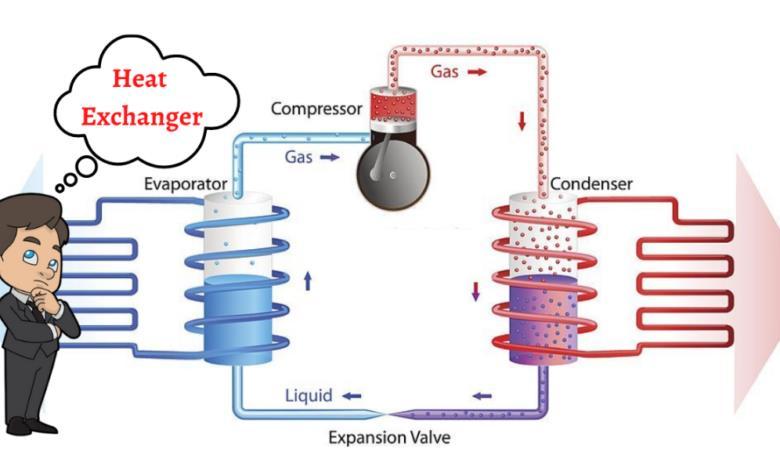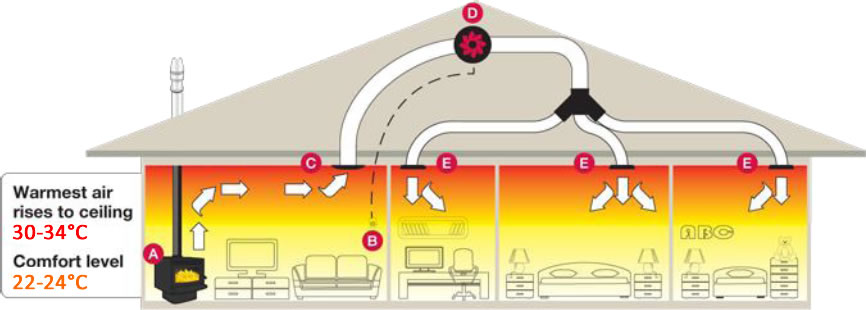Can DVS Heat Transfer Systems Help You Exceed Environmental Compliance Standards?
Wiki Article
A Comprehensive Overview to Selecting the Right Heat Transfer Solutions for Your Demands
Selecting the proper Heat transfer system is necessary for functional performance. Different systems satisfy different requirements, affected by variables such as temperature level range and fluid kind. Recognizing the principles behind Heat transfer, such as convection, conduction, and radiation, is vital. In addition, examining power resources and upkeep methods can impact lasting efficiency. A closer assessment of these factors to consider exposes exactly how to customize a system to particular requirements. What should one prioritize in this facility decision-making procedure?Understanding Heat Transfer: Trick Principles and Principles
Heat transfer may appear like a straightforward concept, it incorporates an array of principles that are essential for reliable system design - DVS Heat Transfer Systems. Understanding these principles is necessary for designers and engineers that aim to maximize thermal efficiency in various applications. Transmission, for example, involves the transfer of Heat through strong products, while convection refers to the activity of Heat within fluids. Radiation, an additional key principle, explains exactly how Heat can be moved via electro-magnetic waves. Each of these mechanisms plays a vital role in figuring out just how power moves within a system. By extensively realizing these concepts, specialists can make educated decisions, ensuring that Heat transfer systems operate effectively and fulfill the certain demands of their applications
Kinds Of Heat Transfer Solutions: A Review
Understanding the principles of Heat transfer prepares for checking out the numerous kinds of Heat transfer systems available. Heat transfer systems can be classified largely right into three types: convection, radiation, and transmission. Transmission involves Heat transfer through strong products, relying upon straight contact between fragments. Convection, on the various other hand, happens in fluids (gases and fluids) where the motion of the liquid itself assists in Heat transfer. Radiation includes the transfer of Heat with electro-magnetic waves and does not need a medium, allowing it to happen in a vacuum. Each kind of system has distinct attributes and applications, making it essential for people and companies to meticulously analyze their specific requirements when selecting the most appropriate Heat transfer remedy.Applications of Heat Transfer Solutions in Various Industries
Heat transfer systems play an important role across different markets, affecting efficiency and product quality. In commercial manufacturing procedures, they help with exact temperature control, while in food and drink handling, they assure safety and security and conservation. Additionally, cooling and heating and environment control systems rely greatly on effective Heat transfer to keep comfortable atmospheres.Industrial Production Processes

Numerous industrial manufacturing processes rely heavily on reliable Heat transfer systems to make the most of performance and enhance item high quality. In markets such as metalworking, Heat exchangers play an essential function in keeping suitable temperature levels during welding, spreading, and creating. These systems guarantee uniform Heat circulation, which is essential for achieving desired material homes. Similarly, in the chemical production sector, Heat transfer systems facilitate specific temperature level control throughout reactions, influencing yield and security. Furthermore, in fabric production, efficient Heat management is vital for coloring and finishing processes, influencing shade consistency and material top quality. By selecting ideal Heat transfer modern technologies, suppliers can enhance energy effectiveness and reduce operational prices, eventually causing a much more affordable and sustainable manufacturing setting.
Food and Drink Handling
Effective Heat transfer systems are similarly essential in the food and beverage processing sector, where keeping suitable temperatures is vital for food safety and top quality. These systems play an important function in procedures such as food preparation, pasteurization, and sterilization, making sure that products are safe for intake and keep their dietary value. Heat exchangers, for circumstances, successfully transfer Heat in between fluids, enhancing energy use while decreasing temperature changes. In addition, refrigeration systems are basic for maintaining disposable things and extending life span. The option of Heat transfer technology straight impacts functional effectiveness and item honesty, making it crucial for food and drink suppliers to choose the ideal systems customized to their specific processing needs. This cautious choice inevitably adds to customer complete satisfaction and food safety and security.
Cooling And Heating and Environment Control
While several sectors rely on Heat transfer systems for performance, A/C (Heating, Ventilation, and Air Conditioning) plays an important duty in keeping interior climate control across various settings. These systems make use of Heat transfer principles to regulate air, temperature level, and humidity top quality, making certain comfort and safety in domestic, industrial, and industrial environments. Appropriately created HVAC systems improve power performance, decrease functional costs, and lessen ecological influence. In commercial buildings, as an example, efficient environment control adds to staff member productivity and consumer fulfillment. In commercial applications, cooling and heating systems help maintain suitable conditions for devices procedure and item conservation. Picking the best Heat transfer system is essential for conference specific environment control needs and attaining overall system performance.Evaluating Energy Sources for Heat Transfer Equipments
In evaluating power resources for Heat transfer systems, a contrast of renewable resource choices and nonrenewable fuel source considerations is crucial. Sustainable resources, such as solar and wind, offer sustainable alternatives that can decrease environmental impact. Conversely, nonrenewable fuel sources remain prevalent because of their well-known facilities and power thickness, triggering a mindful analysis of both options.Renewable Power Options

Fossil Fuel Considerations
Assessing nonrenewable fuel source considerations is crucial for the effectiveness and sustainability of Heat transfer systems. Nonrenewable fuel sources, such as gas, oil, and coal, are typical power sources that provide substantial Heat result, making them preferred choices for commercial and property applications. Nevertheless, their environmental effect, including greenhouse gas emissions and source depletion, elevates issues. When selecting a warmth transfer system, it is vital to assess the accessibility, cost, and regulatory aspects associated with these gas. Additionally, the efficiency of nonrenewable fuel source systems have to be taken into consideration, as greater effectiveness can mitigate some environmental drawbacks. Ultimately, a well balanced approach weighing efficiency and sustainability can assist decision-makers towards one of the most ideal Heat transfer solution for their certain demands.Elements to Think About When Selecting a Warm Transfer System
Selecting an ideal Heat transfer system calls for careful consideration of different elements that can substantially affect performance and efficiency. One essential element is the operating temperature variety, which determines the products and style appropriate for the application. In addition, the sort of fluid utilized in the system-- whether gas or liquid-- influences Heat transfer effectiveness and compatibility. The system's size and ability have to line up with the details requirements of the operation to stay clear of inadequacies. Energy resource schedule is additionally necessary, influencing operating prices and sustainability. Furthermore, the setup atmosphere, consisting of room constraints and accessibility for upkeep, plays a considerable duty in system choice. Finally, governing conformity and security criteria need to be considered to ensure the system satisfies all legal requirements.Upkeep and Performance Optimization for Heat Transfer Equipments
Maintaining Heat transfer systems is vital for ensuring maximum performance and durability. Routine upkeep tasks, such as cleaning up Heat exchangers and evaluating insulation, assistance protect against effectiveness losses due to DVS Heat Transfer Systems fouling and thermal linking. Furthermore, keeping track of system parameters, consisting of stress and temperature, enables for early detection of anomalies, decreasing downtime and expensive repairs. Applying a preventative maintenance timetable can maximize efficiency and extend the life-span of components. In addition, upgrading to advanced control systems can improve operational effectiveness by adapting to varying conditions and loads. By prioritizing upkeep and effectiveness optimization, operators can attain decreased power usage, lower functional expenses, and enhanced general system integrity, eventually leading to much better resource use and a much more sustainable procedure.Future Trends in Heat Transfer Technologies
As industries progressively focus on sustainability and energy effectiveness, future fads in Heat transfer modern technologies are readied to undertake considerable makeovers. Innovations such as innovative products, including carbon nanotubes and nanofluids, assure improved thermal conductivity and performance. Furthermore, the integration of eco-friendly energy resources right into Heat transfer systems is getting momentum, advertising environment-friendly solutions. Smart technologies, consisting of IoT sensors, are expected to reinvent tracking and control, enabling real-time data evaluation for maximized efficiency. Additionally, the growth of portable and modular systems will help with much easier setup and maintenance, dealing with varied applications. These improvements suggest a shift in the direction of more sustainable, effective, and versatile Heat transfer solutions, lining up with international energy goals and environmental standards.
Frequently Asked Inquiries
What Are the Environmental Effects of Heat Transfer Equipments?
The ecological influences of Heat transfer systems can include greenhouse gas emissions, energy intake, and possible thermal contamination. Furthermore, improper disposal of materials and inefficiencies can contribute to resource exhaustion and ecosystem interruption.How Do I Compute the Cost-Effectiveness of a Warmth Transfer System?
To determine the cost-effectiveness of a heat transfer system, one have to assess first expenses, operational expenditures, upkeep demands, and power efficiency, comparing these aspects against the anticipated lifespan and efficiency of the system.Can Heat Transfer Systems Be Utilized in Residential Settings?
Heat transfer systems can indeed be made use of in domestic settings. They give effective heating and cooling options, making homes much more comfy while potentially lowering energy expenses. Their flexibility permits various applications in domestic environments.What Safety Regulations Relate To Heat Transfer Equipments?
Safety policies for Heat transfer systems typically consist of standards on procedure, maintenance, and installation. Compliance with regional structure codes, supplier specifications, and market requirements is important to guarantee reliable and secure system performance in various applications.Just How Do Various Products Affect Heat Transfer Efficiency?

Conduction, for circumstances, involves the transfer of Heat through strong products, while convection refers to the movement of Heat within liquids. Understanding the principles of Heat transfer lays the groundwork for exploring the numerous kinds of Heat transfer systems available. Heat exchangers, for instance, effectively transfer Heat in between liquids, maximizing energy use while minimizing temperature variations. In assessing power resources for Heat transfer systems, a comparison of eco-friendly energy options and fossil fuel factors to consider is vital. Metals, such as copper and aluminum, conduct Heat properly, whereas insulators like rubber and glass slow down Heat flow.
Report this wiki page